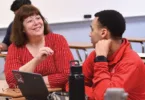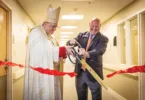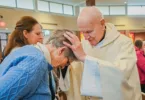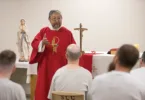St. James Academy in Lenexa does away with traditional student government and implements a new program that gets everyone involved
by Jill Ragar Esfeld
jill.esfeld@theleaven.org
The youngest high school in the archdiocese is making its mark by doing away with traditional forms of student government in favor of an innovative program called the House System.
Patterned after Archbishop Moeller High School in Cincinnati, the House System is a community-centered way of organizing students that promotes unity, allows students to take more ownership of school activities and events, and gives every student in the school an opportunity to build leadership skills.
Most important, the House System structure gives students a home base and support group they can rely on to help them navigate the sometimes stressful world of high school.
“And by the grace of God,” said St. James director of community Maureen Engen, “it’s working here!”
A place to call home
The House System is not only working at St. James — it is thriving. And students are thriving right along with it.
When the high school first opened its doors five years ago, the focus was on providing an excellent education in a faith- filled, community atmosphere.
“This is what we’re called to be,” said Debbie Nearmyer, director of faith forma- tion at St. James. “We are to be one. And we knew [that] to be that, we had to build community.”
The groundwork was laid for today’s House System when students in that first class were divided into communities that met twice a week. But, at that time, the school still had a traditional Student Council and Spirit Club.
By the time St. James reached full capacity last year, it had six communities, each named for a saint and containing a mix of students from different grade levels.
To give students a greater opportunity to become involved through their communities, administrators decided to do away with the traditional council and club structures. (See sidebar on House System below.)
“We took all the events that happen at St. James and divided them up among the communities, to involve more different students than the typical StuCo and give underclassmen a bigger voice within our school,” said Engen.
Houses can be compared to home-rooms in that they meet daily (for 10 and 40 minutes on alternate days) and information is disseminated through them. But that’s as far as the similarities go.
Students are not allowed to study in their houses. It’s a mentoring time and a time to build relationships.
“During those 40-minute days, you’ll see some of them involved in activities or sometimes they have a service project,” said Engen. “They can pray a rosary if they want, they can do adoration on Fridays, they can watch a movie or have cookies — anything they decide on as a group.
“A lot of them will have competitions with other houses or other communities. Essentially, it is a time for them to be together in a more relaxed setting than the classroom.”
The key ingredient to fostering this non-classroom time, said Engen, is the mentor teacher.
Student connection
Nativity parishioner Allison Brancato is a mentor teacher and admits she had concerns at first about how the house time would be spent.
“I almost thought I was going to have to do another lesson plan,” she said.
After a few days in house, however, those fears were put to rest. Students took ownership of their house time and did all the planning.
“My responsibility is really to oversee the kids,” she said. “My house captain and my house leaders really do all the hard work.
“If they want to have a competition in the gym, then I’m the one who has to reserve the gym.”
Brancato said that now, when house time comes, it’s like a breath of fresh air in her day.
“I go in there and see these familiar faces and I’m like, ‘Oh, I’m happy to see all of you,’” she said.
St. Patrick, Kansas City, Kan., parishioner Kim Peterson is a senior at St. James and the school’s captain over all communities. Along with her vice-captain Bren- dan Carney, she serves as liaison between the administration and the communities and as a spokesperson for the school.
Like any St. James student you talk to, Peterson insists her house is the best. And she talks about her housemates as family.
“We get to know our group; we call each other ‘bro’ and ‘sis,’” she said. “If we see each other in the hallways and we don’t say ‘hi,’ we’re going to hear about it when we get back into house.”
The House System has unified students at St. James, diminishing the divisions between class levels and giving everyone a sense of belonging.
“Not everybody is in a sport or not everybody is in a choir,” explained Peterson. “But everybody is in a house, so they all have that feeling that they belong.”
Sophomore Clint McCullough from Queen of the Holy Rosary Parish in Wea, was home-schooled through eighth grade and said the House System at St. James helped him adjust to the high school environment.
“It was kind of a slow adjustment, but the people here are great people, and so it was a pretty smooth transition,” he said.
Much of house time, McCullough said, is spent bonding.
“Sometimes that’s through events, but other times it’s just us sitting down in a circle and sharing our hearts with each other,” he said. “So, we do a little bit of both.
“We talk a lot; and a lot of times we get into spiritual discussions. Mr. Wellnitz (the mentor teacher) really helps us deepen our spiritual life.”
Community spirit
At the next level, students identify with their community. Houses within a community often engage in friendly competition (called “house wars”) or work together on school events and activities.
Student lockers are organized by house and community. Students sit in their communities during pep rallies. Each year, new house members are introduced into each community as part of the initiation into St. James.
“This year, all the upperclassmen went down and sat by community [in the gym],” recalled Peterson. “Then we led the freshmen down and, as they were called into their communities, the community was cheering for them.”
Each community is supervised by a dean, whose job is to be supportive of the mentor teachers and students in the leadership positions.
Representing each community are two seniors who are community captains. They stay in close communication with the dean and function as liaisons to the houses.
“What makes our system so unique is it is very student-driven,” explained Nancy Dorsey, dean of St. Gianna Molla Community. “As a dean, I am responsible for saying, ‘OK, homecoming is coming up. Here are a list of things that need to get done.’
“I delegate those responsibilities to the community captains and say, ‘Your responsibility now is to go out to your houses.’”
Corpus Christi, Lawrence, parishioner Katie Wohletz is a senior at St. James. She is amazed at how many more students get involved in organizing school activities and events now that the House System is in place.
“My first three years we had normal Spirit Club and StuCo,” she said. “What I think is cool about this is that people who never would have gotten involved before are involved now.”
Dorsey was head of the former Spirit Club. She too is amazed at how many more students are stepping up to help out now.
“This program allows for so many more people to get involved,” she said. “And you’re involving people who otherwise never would have had the confidence to stand up and say, ‘I can do that.’ That’s why it is so great.”
Belonging
The House System has done wonders to bridge gaps between students who may never have been friends before — sophomores and juniors who might have a lot in common, or seniors who might help a freshman get acclimated to high school.
“There aren’t nameless faces in our high school,” said Nearmyer. “Everybody knows everybody.”
“I don’t even know how to explain it,” Wohletz said. “There aren’t words for it. I’m best friends with a freshman; I’m going to dinner with a sophomore today. That never would have happened before.”
Peterson agreed and said she is especially glad that students are placed in houses randomly.
“At first, we wanted our friends in there,” she explained. “But I have classes with my other friends. I have other opportunities to see them.
“Now I’m getting to know this football player who never would have been my friend before — because he was too cool. And now I’m like his sister.”
From a Catholic faith perspective, Nearmyer believes St. James is on the right track.
“Everything we teach and talk about in the Mass and in our religion classes — we need to live it outside those two places, in our hallways, “ she said.
“This has been a really phenomenal way to make a school of 600-plus kids a little smaller,” she concluded. “Kids here are known to one another and know how to look out for each other.”






